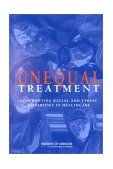Home | Healthcare Finance | Healthcare Cost Accounting | Healthcare Providers | Healthcare Treatment | Managed Care | Healthcare Quality Management | Healthcare Information Technology | Free Space Optics | Optical Wireless Networking | Optical Networking
Unequal Treatment: Confronting Racial and Ethnic Disparities of Healthcare

Report from the Committee on Understanding and Eliminating Racial and Ethnic Disparities in Health Care and the Board on Health Sciences Policy. Examines how disparities in treatment may arise in healthcare systems and looks at aspects of the clinical encounter contributing to such disparities. Highlights cross-cultural education to improve communication.
Category: Healthcare Treatment
Title: Unequal Treatment: Confronting Racial and Ethnic Disparities of Healthcare
PURCHASE INFO: http://www.e-tba.com/buy-0309085322.htm
Released Date: January 2003
Price: $79.95
Publisher: National Academies Press
Author: Institute of Medicine
Summary: The life expectancy of members of most minority groups in the United States is shorter than it is for white Americans. For example, the gap in life expectancy between black Americans and white Americans is about six years. Against this bleak backdrop, a group of scholars assembled by the Institute of Medicine has taken on the issue of racial disparities in health care. In Unequal Treatment, they deal with several questions. In the United States, are there disparities in treatment between patients who are members of minority groups and those who are not, when both groups have similar access to care? If so, can we determine what underlies these disparities and what we should do about them? The medical literature reviewed in this book should convince even skeptics that members of minority groups receive treatment for their health problems that is different from the treatment received by others. However, determining whether these differences exist when all patients have equal access to care is a thornier issue. Two approaches are commonly used to analyze this problem: one is to examine the treatment of patients at a single location; the other is to investigate the treatment of patients who have the same insurance. Unfortunately, both of these experimental designs fall short of the ideal condition, in which all patients have equal access to the same range of services and expertise. As a result, no one can be certain whether disparities in treatment reflect unequal treatment of two groups of patients with equal access to health care or unequal treatment of two groups owing to a difference in resources, such as the availability of subspecialists and well-stocked pharmacies. After careful consideration of the evidence, the editors favor the former explanation: unequal treatment despite equal access. They ground this view in well-described and engaging theories about the roles of race, nonverbal communication, and inferential thinking that invisibly alter the clinical encounter between a patient who is a member of a minority group and a physician who is not. They conclude that "stereotyping, biases, and uncertainty on the part of the healthcare providers can all contribute to unequal treatment." This conclusion is important and remarkable, in that it redefines the problem of disparities in health care as a problem not of uneven access but of moral failure. In this context, the editors' recommendations make sense. Poor treatment of minorities should be considered an abrogation of civil rights. Doctors' understanding of their minority patients should be enhanced through educational programs on disparities in treatment and on cultural competency. The medical profession's myopia regarding minority issues should be addressed by enriching the physician workforce with more members of minority groups. I believe, however, that if we focus our attention on eliminating racial disparities, we will fall short of our aspirations. Decades of research have shown that the care received by patients who do not belong to a minority group is also frequently of poor quality, meaning that by aiming for parity we aim too low. An alternative is to focus purely on maximizing the quality of care received by underserved populations. Our success in this endeavor would be reflected within these communities, rather than measured by comparison with other populations. We could provide additional reimbursement to physicians who treat underserved patients, rather than threaten them with charges of civil-rights violations. In England, the National Health Service has experimented successfully with a deprivation payment system. According to this system, general practitioners who work in underprivileged areas of the country receive additional reimbursement for the care they provide, in part on the premise that the barriers to providing optimal care are greater in such areas. We could also target the specific conditions that most impair health and economic viability in minority communities. Currently, childhood asthma is rampant in inner cities and has severe economic consequences for affected families: every exacerbation requires both the child and the caregiver to stay at home, thus impeding the child's educational success and the adult caregiver's professional success. Harlem Hospital, in New York City, has engaged in intensive community outreach that has mitigated the burden imposed by this condition. If our aim is to follow Harlem Hospital's lead on a larger scale, it will be better served by educating doctors about the strong relation between poverty and environment than by educating them about the relatively weak relation between skin color and treatment preferences. These alternative approaches could have received more consideration in this engaging book. Peter B. Bach, M.D.
Copyright © 2003 Massachusetts Medical Society. All rights reserved. The New England Journal of Medicine is a registered trademark of the MMS.
Description: Report from the Committee on Understanding and Eliminating Racial and Ethnic Disparities in Health Care and the Board on Health Sciences Policy. Examines how disparities in treatment may arise in healthcare systems and looks at aspects of the clinical encounter contributing to such disparities. Highlights cross-cultural education to improve communication.
site map
(c) Copyright 2001 {e-TBA.com, Inc.}. All Rights Reserved.
E-TBA Bookstore in association with Blackbaud Software, provider of
Fundraising Software Solutions and Non-Profit Consulting
Enrollment Management
Membership Management Software
Parse error: syntax error, unexpected '"', expecting T_STRING or T_VARIABLE or T_NUM_STRING in /usr/www/users/seoadvan/www_etba_com/randomquotes/randomquote.php on line 5
|

